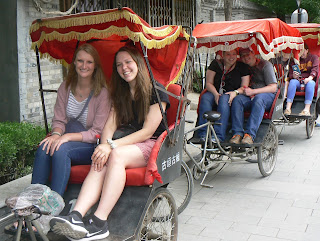May 19
We have reached our last
full day in China, and the overall emotions of the group are mixed. Many are
excited to go back to the simple luxuries the United States has to offer like
toilet paper in stalls, safe tap water to drink, and other things like that. On
the other hand, it has been an amazing cultural experience filled with new
food, sites, and a definite language barrier.
To start the day off, we
went to Tian'anmen Square. It is the largest city square in the world, covering
an impressive 110 acres of land. While there, we saw many soldiers and officers
patrolling the site 24/7, which was something very different compared to what
we might see in America. The largest building in the square was called the
Heavenly Peaceful Gate in English, and they also had an entire building to
honor Chairman Mao's burial site. He is known as the Father of China to the
locals. We were surrounded by countless other tourists and found out that over
100,000 visitors go to Tian'anmen Square every day.
After Tian'anmen Square, we
headed to the Forbidden City. There was a park right outside the city with many
locals doing group tai chi surrounded by trees that were over 200 years
old. The Forbidden City is home to 1.8
million ancient treasurers of China's history from past dynasties. The Home of
Supreme Harmony building also has 13,844 painted and carved dragons on it from
top to bottom. One piece of information we learned during this tour was about
the Empress and how she slept on a stone pillow with a hole in it so that she
could hear when people would try to come in to kill or harm her.
Our entire group then got a
chance to take a rickshaw ride around the ancient Huotong Beijing neighborhood.
Rickshaws are bicycles with 2-person carts in the back to ride on. They are
mostly powered by the person pedaling but sometimes will have a small motor to
assist them. Lunch was provided to us at a local villager's home. In their
courtyard, they had birds, grasshoppers, and even crickets in small cages that
they kept as pets. It was very cool to see the homes they live in, and we
learned that the small 4-room homes are worth at least $2 million (USD) each!
Next we visited the Earthly
Peaceful Gate where the bell tower signified the morning and the drum tower let
people know the work day was done. This is where the time was tracked in the
days before technological time keeping. After climbing a wall of steps that
seemed comparable to The Great Wall, we got to see the drums that went off
every 12 hours to signal that it was time for the farmers to come back to the
village. One drum was an original drum dating back to the Ming Dynasty. After a
short break, our next adventure was to an acrobatic show. At the show, we got
to see many talented individuals perform, with one of the acts including five
girls hanging from a ball spinning at a rapid speed in the air.
To end the last full day in
China, we had one of our best meals, Peking duck. The meal included many common
Chinese side dishes and the duck. The duck took days of roasting, and the
result was tender, juicy meat. We were able to make tacos out of the duck, and
it was a favorite for several in our group. Because it was such a delicious
meal, this was definitely the "wow" moment of our day!
Acrobatic show
Gift from Michelle
In front of the Forbidden City
Inside Forbidden City
Inside Forbidden City
New friends at Tianemann Square
Peking duck
Pet cricket
Rickshaw ride























































